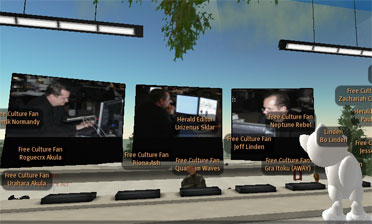Eons ago, when the institute was just starting out, Ben and I attended a web design conference in Amsterdam where we had the good fortune to chat with Steven Pemberton about the future of the book. Pemberton’s prediction, that “the book is doomed,” was based on the assumption that screen technologies would develop as printer technologies had. When the clunky dot-matrix gave way to the high-quality laser printer, desk top publishing was born and an entire industry changed form almost overnight.
“The book, Pemberton contends, will experience a similar sea-change the moment screen technology improves enough to compete with the printed page.”
This seemed like a logical conclusion. It seemed like the screen technology innovations we were waiting for had to do with resolution and legibility. Over the last two years if:book has reported on digital ink and other innovations that seemed promising. But the fact that we were looking out for a screen technology that could “compete with the printed page,” made it difficult for us to see that the real contender was not page-like at all.
It’s interesting that we made the same assumptions about the structure of the ebook itself. Early ebook systems tried to compete with the book by duplicating conventions like the Table of Contents navigational strategy, and discreet “pages,” that have to be “turned” with the click of a mouse. (And, I’m sorry to report, most contemporary ebooks continue to cling to print book structure). We now understand that networked technologies can interface with book content to create entirely new and revolutionary delivery systems. The experiments the institute has conducted: “Gam3r Th30ry” and the “Iraq Quagmire Project” prove beyond question that the book is evolving and adapting to networked culture.
What kind of screen technology will support this new kind of book? It appears that touch-screen hardware paired with zooming interface software will be the tipping point Pemberton was anticipating. There are many examples of this emerging technology. In particular, I like Jeff Han’s experimental work (his TED presentation is below): Jeff demonstrates an “interface free” touch screen that responds to gesture and lets users navigate through a simulated 3D environment. This technology might allow very small surfaces (like the touchpads on hand-held devices) to act as portals into limitless deep space.
And that brings me around to the real reason the touchscreen zooming interface is the key to the next generation of “books.” It allows users to move into 3D networked space easily and fluently and it gets us beyond the linearity that is the hallmark and the limitation of the paper book. To come into its own, the networked book is going to require three-dimensional visualizations for both content and navigation. Here’s an example of how it might work, imagine the institute’s Iraq Study Group Report in 3D. Main authors would have nodes or “homesites” close to the book with threads connecting them to sections they authored. Co-authors/commentors might have thinner threads that extend out to their, more remotely located, sites. The 3D depiction would allow readers to see “threads” that extend out from each author to everything they have created in digital space. In other words, their entire network would be made visible. Readers could know an author’s body of work in a new way and they could begin to see how collaborative works have been understood and shaped by each contributor. It would be ultimate transparency. It would be absolutely fascinating to see a 3D visualization of other works and deeds by the Iraq Study Groups’ authors, and to “see” the interwoven network spun by Washington’s policy authors. Readers could zoom out to get a sense of each author’s connections. Imagine being able to follow various threads into territories you never would have found via other, more conventional routes. This makes me really curious about what the institute will do in Second Life. I wonder if you can make avatars that act as the nodes for all their threads? Perhaps they could go about like spiders, connecting strands to everything they touch? Hmmm.
But anyway, in my humble opinion the sea change is coming. It’s going to be three-pronged: screen technology, networked content, and 3D visualization. And it’s going to be very, very cool.

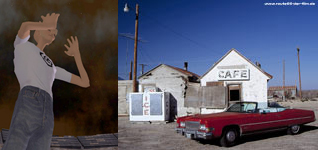
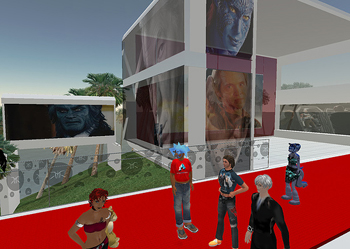

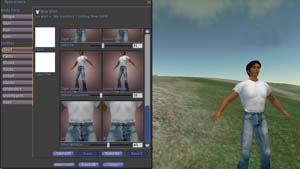 People around me have much more sophisticated outfits than I do. So, I try out the free clothing features. I darken my pants to a deep blue and my shoes black. Then, my default shirt gets turned into a loose white t-shirt. Somehow I end up a bit like a GAP model crossed with Max Headroom. After making my first “friend,” another complete stranger comes up to me and just starts giving me clothes. Apparently, my clothes still need a little work. I try on the cowboy boots and faded jeans. Happy that I’ve moved beyond the standard issue clothes, I thank my benefactor and begin to make my way to the event.
People around me have much more sophisticated outfits than I do. So, I try out the free clothing features. I darken my pants to a deep blue and my shoes black. Then, my default shirt gets turned into a loose white t-shirt. Somehow I end up a bit like a GAP model crossed with Max Headroom. After making my first “friend,” another complete stranger comes up to me and just starts giving me clothes. Apparently, my clothes still need a little work. I try on the cowboy boots and faded jeans. Happy that I’ve moved beyond the standard issue clothes, I thank my benefactor and begin to make my way to the event.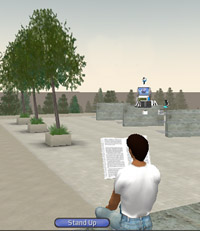 The interview is about to begin, as an avatar with large red wings walks by me. I say out loud, “I know she was going to sit in front of me.” Adding, “Just kidding,” in case I might be offending someone, who knows who this person could be. Fortunately, she found a seat outside my sight line without incident, and the introductory remarks began.
The interview is about to begin, as an avatar with large red wings walks by me. I say out loud, “I know she was going to sit in front of me.” Adding, “Just kidding,” in case I might be offending someone, who knows who this person could be. Fortunately, she found a seat outside my sight line without incident, and the introductory remarks began.